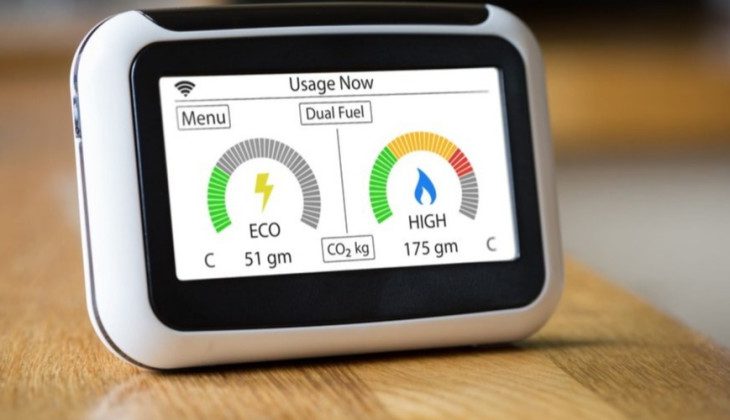Buying green energy
You can sign up to buy gas and electricity from an energy supplier that focuses on sourcing energy from renewables see our green energy tariff info or you can look at greener energy tariffs provided by your current supplier. A ‘green energy tariff’ means your supplier will buy a certain amount of renewable energy on your behalf, based on the electricity you use. This is then fed back into the National Grid, which means that the more people who sign up for a green energy tariff, the larger the proportion of renewable energy we have in the UK’s energy mix.
Smart meter benefits – no more meter readings!
Installing a smart meter is one of the easiest ways to gain control of your energy usage, save money on energy bills and cut your household carbon emissions.
Smart meters are aiding the transition to a greener, more reliable energy system. They enable quicker and cheaper repairs, as well as innovative smart tariffs allowing you to save money by using energy in non-peak hours or when there is excess clean energy – on very windy days for example. Electric vehicles, heating and smart appliances can all be connected to a smart meter and you can then programme activity to automatically tap into cheaper energy rates.
With a smart meter, you are only charged for the energy you actually use, rather than having to pay bills that estimate how much you use. This makes it easier to budget as you won’t be under or over charged. Energy suppliers also offer some of the cheapest tariffs to households with smart meters. For prepayment customers, smart meters allow you to top-up remotely whenever and wherever you like and see credit balances on an In-Home Display.
If your smart meter was installed before 2018, it is probably a first-generation SMETS1 meter. Post 2018, you may have been issued with a SMETS2 meter, which has a few smarter features. Your supplier will be able to upgrade your meter from SMETS1 to SMETS2 either by physically replacing it or with a remote software upgrade.
The UK government requires all energy suppliers in England, Scotland and Wales to provide customers with smart meters and the aim is for everyone to have one by 2024. Smart meters for gas and electricity can record your price and consumption data every half an hour (for gas) and close to real time (for electricity) and send meter readings to your energy supplier automatically.
Contact your energy supplier to arrange free smart meter installation at a time and date convenient for you.
Home energy use options
There is a new breed of home energy saving options available, such as the free energy saving app Loop. The app links to your smart meter and can give you an objective analysis of your energy usage, with personalised recommendations, making it easier to switch suppliers. The Loop home energy monitor measures electricity consumption every 10 seconds compared to the smart meter’s 30-minute measurement.
The data collected by Loop can translate into recommendations for cheaper tariffs, as well as being able to give accurate estimates of the effect of installing solar power and batteries. Smart meters don’t interpret the data in this way or provide advice.
Utrack by Uswitch is another way to control your home energy costs. This is a free energy tracking app supporting the Government’s ‘It All Adds Up’ campaign for saving energy. It provides detailed cost charts daily, weekly, monthly and annually, as well as providing alerts, tips and personal reports.
Other options for apps which give real time view on data use are the Bright app from Hildebrand (available from iOS and Android app stores) and the ivie app found here. If you’re an Octopus follower a good app giving tariff information is Octopus Compare.
Current and future government policy
Energy efficiency is now a national energy priority in the UK, as the government focuses on increasing energy security and lowering household and business energy costs. The invasion of Ukraine, global energy shortages, rocketing prices and cold snaps of weather have put extra pressure on our electricity grid.
For the first time, people are being asked to cut down on energy usage in exchange for money. Energy suppliers (26 suppliers as of 16 February 2023) are offering those with smart meters the chance to save on their bills in return for cutting energy usage at peak times.
The aim of the National Grid’s Demand Flexibility Service (DFS), first piloted by Octopus Energy with 100,000 customers in November 2022, is to avoid the need for emergency generators – which are expensive and bad for the environment – or enforced blackouts. The DFS should help us reduce our energy consumption and keep blackouts and emergency generators at bay.
To take part, you need a smart meter and an energy supplier that is signed up to the scheme. Energy saving sessions will last around an hour and ask you to lower your energy consumption by around 30%. So no need to turn off the TV and sit in the dark, but refrain from using energy-intensive appliances such as cookers, washing machines and dishwashers. You could save £3 for every kilowatt-hour of energy saved. This could add up to a total of £100 over a 5 month period.
Although not all suppliers have signed up, don’t despair or start switching straight away! Loop is opening the scheme up to an estimated 12.9 million users through its ‘Turn Down and Save’ scheme, which can be accessed by any household with a smart meter. This is just the start of this type of scheme and hopefully customers will be able to save more in the future.
Use of EV batteries for domestic storage
Soon, we will be able to use electric vehicles as to store electricity to power our homes – i.e. as a big storage battery, stocking up on electricity from renewable sources like wind and solar power, or from the grid during off-peak hours.
The technology for using an EV as a rechargeable battery is not yet available, but it is in development. ‘Vehicle-to-grid’ (VTG) or ‘vehicle-to-house’ (VTH) technology would not only allow specially designed new EVs to power homes and businesses when not driving, but could also feed back into the grid.
This is great news for the transition to solar and wind power – the UK’s largest renewable energy sources – which are only available when the sun shines and the wind blows. BMW, Peugeot, Volkswagen, and Fiat have all started working on these EV models.
See here for more details on EVs.



